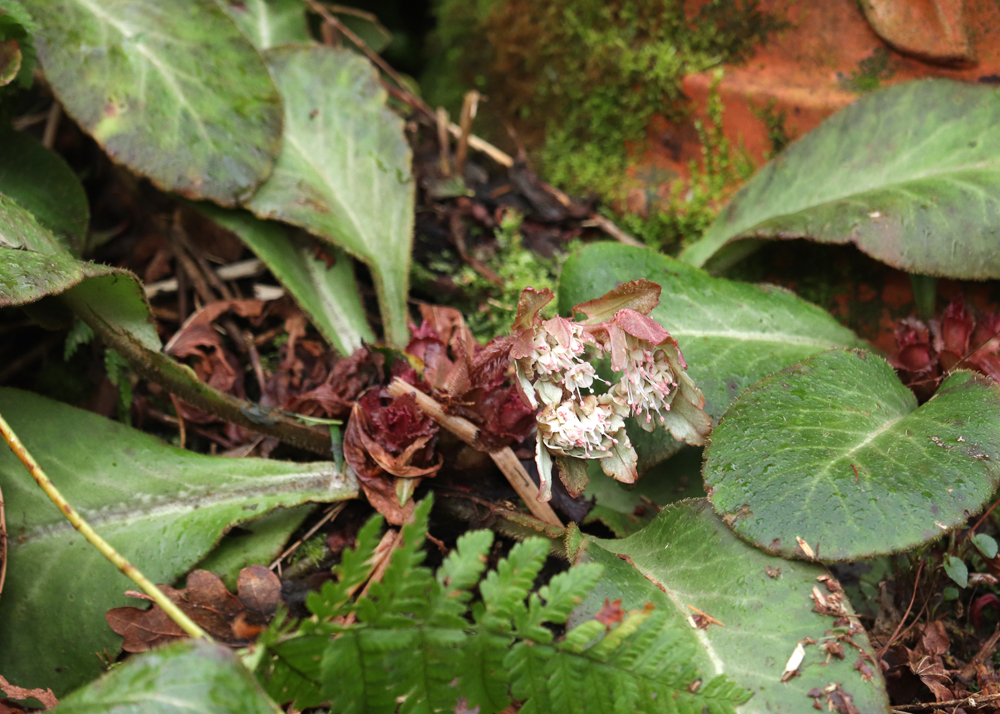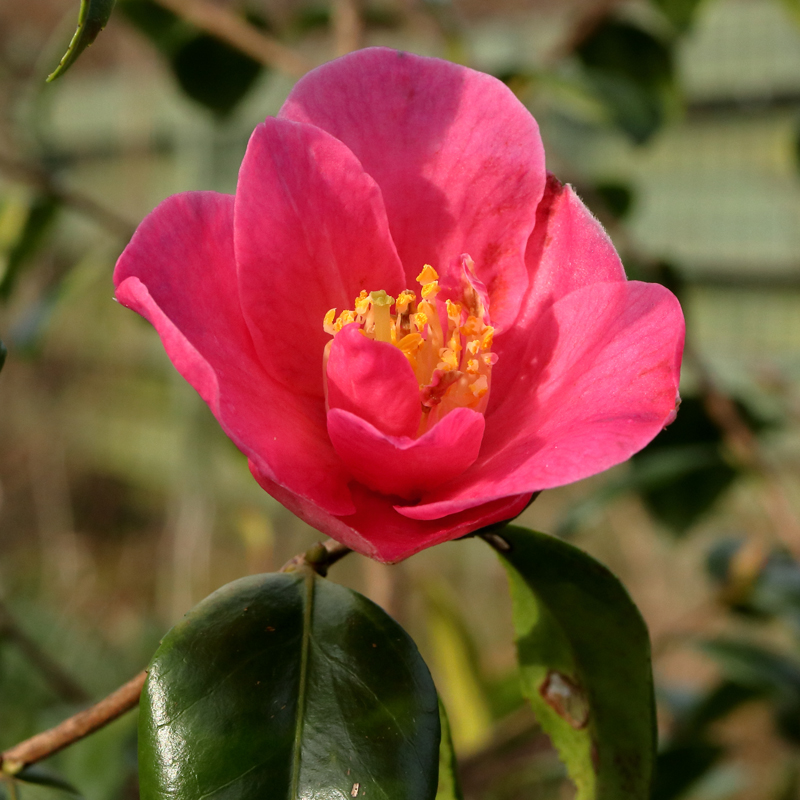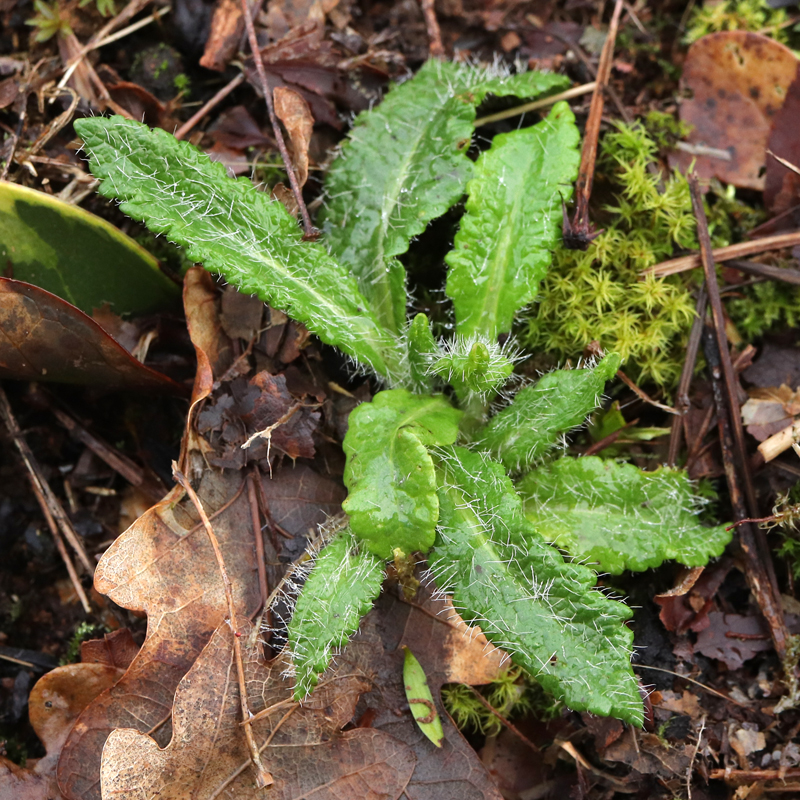Having rained all night, it’s due to clear into a half decent day. We’ll see, at the moment it doesn’t look promising. It was forecast so I made sure I had some pictures in the can yesterday. I was thinking I might be able to find half a dozen things flowering even after the cold spell but it wasn’t to be. But look hard enough and there’s always something happening.
One.
Camellia ‘Minato-no-akebono’. I’ve done this before, about a month ago soon after it started flowering. It was really getting into its stride when the cold spell hit but seems to have come through pretty much unscathed. Some of the blooms that were fully open were singed a bit, the rest were fine. The coldest night was -2.8°C, I don’t think it could have taken much more without losing all its flowers.

Two.
Last saturday I was bemoaning the non-arrival of some reduced tulip bulbs I’d ordered from Peter Nyssen before Christmas. They turned up the same day and have been planted in 20L pots which have been dropped into the holes vacated by Alstroemeria ‘Indian Summer’, which had been frosted, cut down and moved up to my tunnel. The trays are to stop cats using them as toilets. I’m quite surprised the Echiums just behind them have survived. When I dug out the Chamaerops that was where these pots now are, I disturbed seeds of Echium that had been there since 2013, and which germinated in large numbers. I potted a few up but can’t remember where I put them.

Three
Chrysoplenium macrophyllum. This disappears for summer under Astilbe and Impatiens omeiana, it’s bedfellows in my ex-pond bog garden. At this time of year it has the space to itself and both flowers and puts out runners which produce new rosettes of big leaves. It warrants the most muted of wows, but it’s better than nothing. It might look better in a week or two and if so, I’ll post it again. Then again, it might look worse.

Four.
Yucca gloriosa ‘Variegata’. Just beside the tulip pots in the front garden is a variegated Yucca. Until now it has had a single stem and has flowered and branched to create a chunky dense crown a couple of feet above the ground. Now it has a pup growing at one side. I don’t think I want it there, the existing plant will push it over into the neighbour’s garden. Maybe I’ll give it a year then try to take a cutting of it. Is that something anyone has done? I haven’t looked up yucca propagation but I suspect it’s pretty easy. I need to do some weeding round it too.

Five.
Camellia ‘Koto-no-kaori’. Like ‘Minato-no-akebono’, this is a lutchuensis hybrid, meaning it is also scented. It is in many respects a better plant, the foliage colour is better, it doesn’t start to flower so early so is a bit less vulnerable to frost and the flowers have a stronger colour. Somewhat predictably it doesn’t have quite as strong a scent. Even so, if I could keep only one of the pair it would be this one. The flowers are slightly smaller than ‘Minato-no-akebono’ at 6cm across and this is the first to open this season. The name means Perfume of Ancient Capital, from which I infer that unlike here, Japan’s ancient cities didn’t have open sewers running through the streets.

Six.
Papaver horribilis. I said yes to this offering from someone with the sort of garden where the thugs fight it out for space and the weak go to the wall. I seem to remember it having untidy semi-double orange poppy flowers, maybe P. orientalis in some very unrefined form. I have had it for a couple of years and don’t remember it flowering but it has spread, presumably by runners, about three feet in all directions, and through all manner of better plants. I suspect that if I try to dig it out I will simply propagate it so I will probably use glyphosate on it, just a quick squirt at the larger rosettes, and hope that it realises it’s not wanted. I’m generally quite good at saying no because once you’ve accepted something people keep asking how it’s doing and saying you had second thoughts and binned it seems unkind.
That’s it for another week. Links to other sixes are here, and here, also here.

That poppy is a persistent bugger, a damned nuisance. I’ve dug it out again and again and it still appears.
LikeLike
I can’t really dig it, the bed is full of bulbs and all sorts. It’s going to go though.
LikeLiked by 1 person
I keep pulling out the new growths as soon as they are big enough to handle. With me, they are among snowdrops and cyclamen coum and a nuisance as they would swamp them so easily.
LikeLike
I’m hoping that with very careful use of chemical I can rid myself of it altogether. I don’t want a never ending running battle.
LikeLiked by 1 person
Quite a few years ago I used Roundup but it wasn’t successful. The roots run deep and are difficult to eradicate, even chemically.
LikeLike
OK. I will give it a try anyway, and keep a note of what I do, since if I succeed to eliminate it, it may be of interest to others. Also if it doesn’t succeed.
LikeLiked by 1 person
Many yucca that are not endemic to deserts are easy to propagate from big cuttings. Desert yuccas rot before developing roots, although I know it must be possible to grow them from cuttings too. (Joshua tree is very susceptible to decay!) The giant yucca is so easy to grow from cuttings that I have not found a cane that is too big to take root. Seriously, I cut them to fit into the bed of the pickup, which is eight feet long, and they all rooted as ready-to-go fence posts. With three feet into the ground, about five feet stood above ground. I could have gotten them taller if I wanted to. Anyway, Yucca gloriosa is not quite so easy. The cutting should not be stuck so deeply, and if possible, lain on the ground and barely covered with damp sand until roots begin to appear. Once the roots appear, the cutting can be stood up vertically. Much of the foliage should be cut off rather than peeled off. The stubble should be left on the cane, and can be removed later as it starts to grow. Leaves that are higher than 45 degrees from the meristem can stay.
LikeLike
There used to be a yucca grown over here as a house plant that you could buy and grow from lengths of stem, 2-3 feet usually. Would that have been giant yucca I wonder. Yucca elephantipes is what it seems to be, looking online. I was hoping the shoot on mine would have some roots on it, given it’s coming from below ground, if not now then in a year or two’s time. Given how slowly they grow here, I doubt it would have much stem at all, just a rosette of leaves. Cutting off most of the foliage wouldn’t be a problem and would make it much easier to handle. I seem to remeber that when we grew them in pots they produced runners that tried to grow through the sides of the pot but which we could cut off and grow on. There may be shoots like that under my big plant.
LikeLiked by 1 person
Yes, the houseplant sorts are giant yucca, Yucca elephantipes. Other tropical yuccas would work as houseplants too, but are rare, perhaps because giant yucca grows so much faster.
Yucca recurvifolia produces more runners, and is sometimes and too often marketed as Yucca gloriosa, just because it is easier to grow. They are difficult to kill once they get into a landscape.
If the offending rosette does not need to be removed right away, you may want to wound the underside of the trunk where it lays on the ground, or even below grade where it emerges from the ground, and then bury the wound. That may promote root growth before it needs to be moved. Rooting hormone may help as well, although I have never used rooting hormone on a yucca.
LikeLike
Seems likely that now one shoot has come up others will follow, so I’ll probably get plenty of chances to perfect my technique.
LikeLiked by 1 person
Yes, perhaps. It seems that when a big but sparse plant opens up space at the base, whether because the canes get taller, or they just lean over, the space fills with pups. It is supposed to be a mounding plant, which is why it is known as the mound lily.
LikeLiked by 1 person
I didn’t know that there were scented Camellias. Lovely. This post is going to mean I need to spend some money!
LikeLike
There are scented Camellias but they fall into two broad groups. There are the autumn flowering types that get lumped together as “sasanquas”, which if they have scent have a somewhat pungent, somewhat oily scent. Not unpleasant but not sweet like the other group, consisting of a number of species like C. grijsii, C. tsaii, C. yuhsienensis and the species C. lutchuensis and a growing number of its hybrids, like the two I mentioned. They are not very widely available, I think Trehane Nursery have some and Pepinieres Stervinou in France have some. If you’re ever down in Cornwall I usually have a few small plants kicking about too.
LikeLike
I almost went away to google the sewerage systems of Japanese cities. Maybe they were more advanced than us or maybe they used the Camellia scent to disguise the smells. I know I’ll have to look this up eventually. Beautiful camellias as ever Jim.
LikeLike
Or maybe their modern plant names are an attempt to rewrite the past. The thought that you could look up ancient Japanese sewerage systems on the web and almost certainly find more than you want to know is unsettling. It wasn’t like that when I was young, you could plead ignorance in life and get away with it. What used to be research is now looking up.
LikeLike
Listen to me Jim, and repeat: : ” I think I may have grown that one some time ago, but now I am thinking of something different”. a good way of saying no kindly is to say? Or are you too honest? Your papaver looks more like a thistle one of those horrible creeping ones to my untutored eye. Keep Safe.
LikeLike
I really don’t have space in suitable conditions, in fact I’ve already got a couple of things needing the same conditions, I’d better plant them first. There’s that thing where you go round a garden that could be much better than it is and out of politeness get a bit gushy about the one or two things that do look nice, then find yourself trapped when they offer you a plant of it. I never was well schooled in social graces. The overfull already defence is the one I usually use. It’s honest, but it’s never stopped me when I visiting nurseries. I could say I thought the poppy was a thistle.
LikeLike
Saying no to offers of plants you don’t really want sounds very wise. I offered my mother-in-law our Jasmine humile ‘Revolutum’ the other year which she accepted. The following summer when she was giving my wife and I a tour of the garden it had gone (I suspect it grew too vigorously). When asked what had happened to it she scratched her head and said “Well, that’s odd. I don’t know.” Presumably it had wandered off, as shrubs do.
LikeLiked by 1 person
Once things are gone I forget I ever had them very quickly, even without little white lies.
LikeLiked by 1 person
Your camellias are so pretty, I love visiting you just to see what you have. My tulips from SR were late in arriving and some were quite mouldy! I complained and got a partial refund, now to see if any of them actually grow.
LikeLike
I was pleasantly surprised at how good my tulips looked when they arrived, starting to grow but almost all perfectly healthy. I added a tab for my favourite camellias on my camellia blog at https://jimscamellias.com/ and put ‘Minato-no-akebono’ on it yesterday while I was at it with the pictures. I had planned to do several more but I’m not really able to go to Mt Edgcumbe with this lockdown on.
LikeLiked by 1 person
I must visit that blog when I need another fix.
LikeLiked by 1 person
The Chrysoplenium *checks to further up the page to check I’ve spelt it right* looks very promising. Do you know if it’s related to Bergenias at all? It looks quite similar in some respects. Anyway, great stuff – nice to see a bit of colour!
LikeLike
Both Chrysoplenium and Bergenia are in Saxifragaceae. Chrysoplenium macrophyllum is not very typical of its genus though, they mostly have small leaves and yellow/green flowers. I try to keep C. davidianum going but it wants wetter conditions than I’ve got.
LikeLike
Good to know. Thanks!
LikeLiked by 1 person
Still quite a lot of colour in your garden. Interesting Six-on-Saturday.
LikeLike
The frost saw off all last years hangers on, fuchsias mainly. It’s all new season stuff from here on in.
LikeLike
Propagating yucca is very easy to do; it takes root easily. I find it even easier than cordyline.
You are right to wait at least for spring.
LikeLike
I’m hoping it’ll have some roots already when I remove the shoot, I’m in no rush.
LikeLiked by 1 person